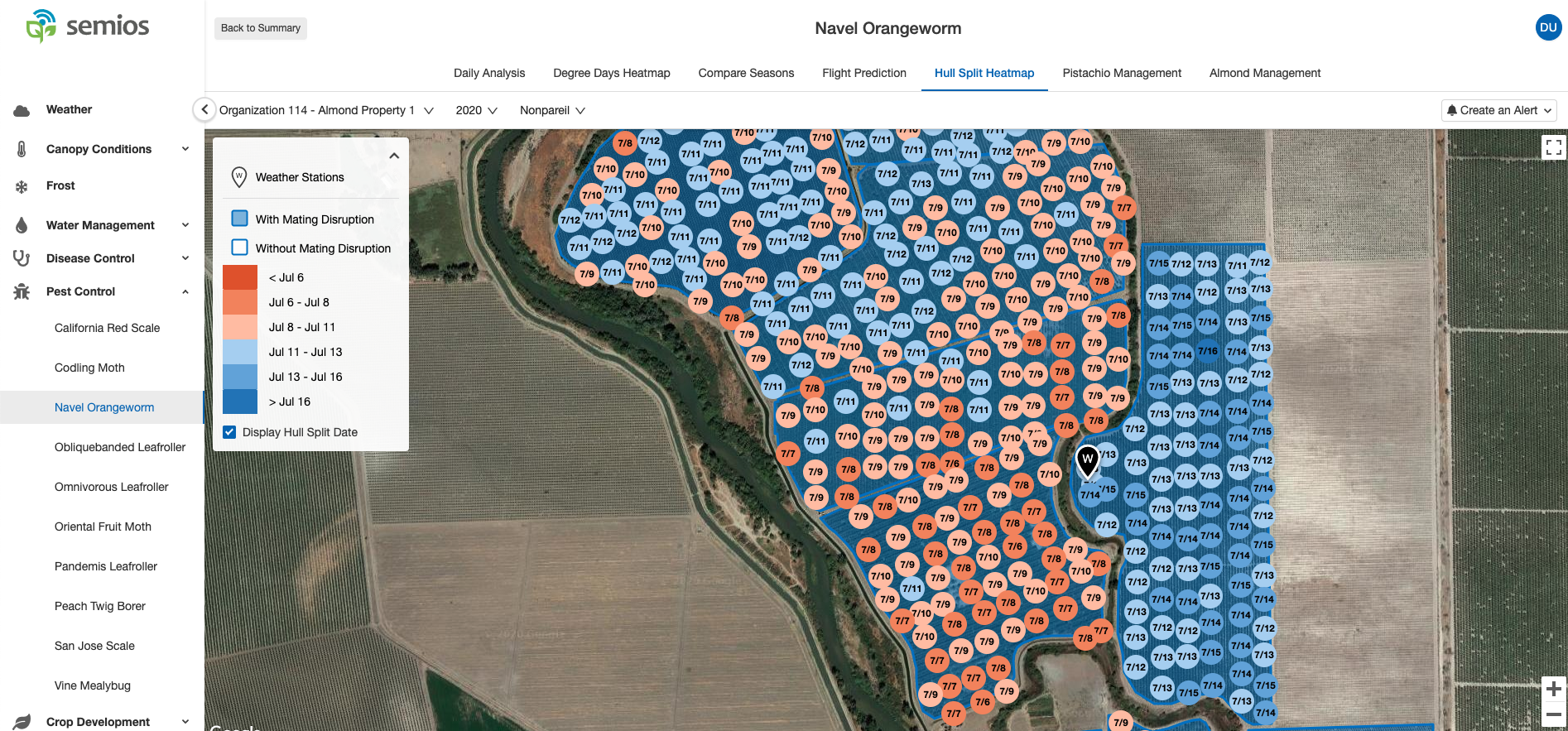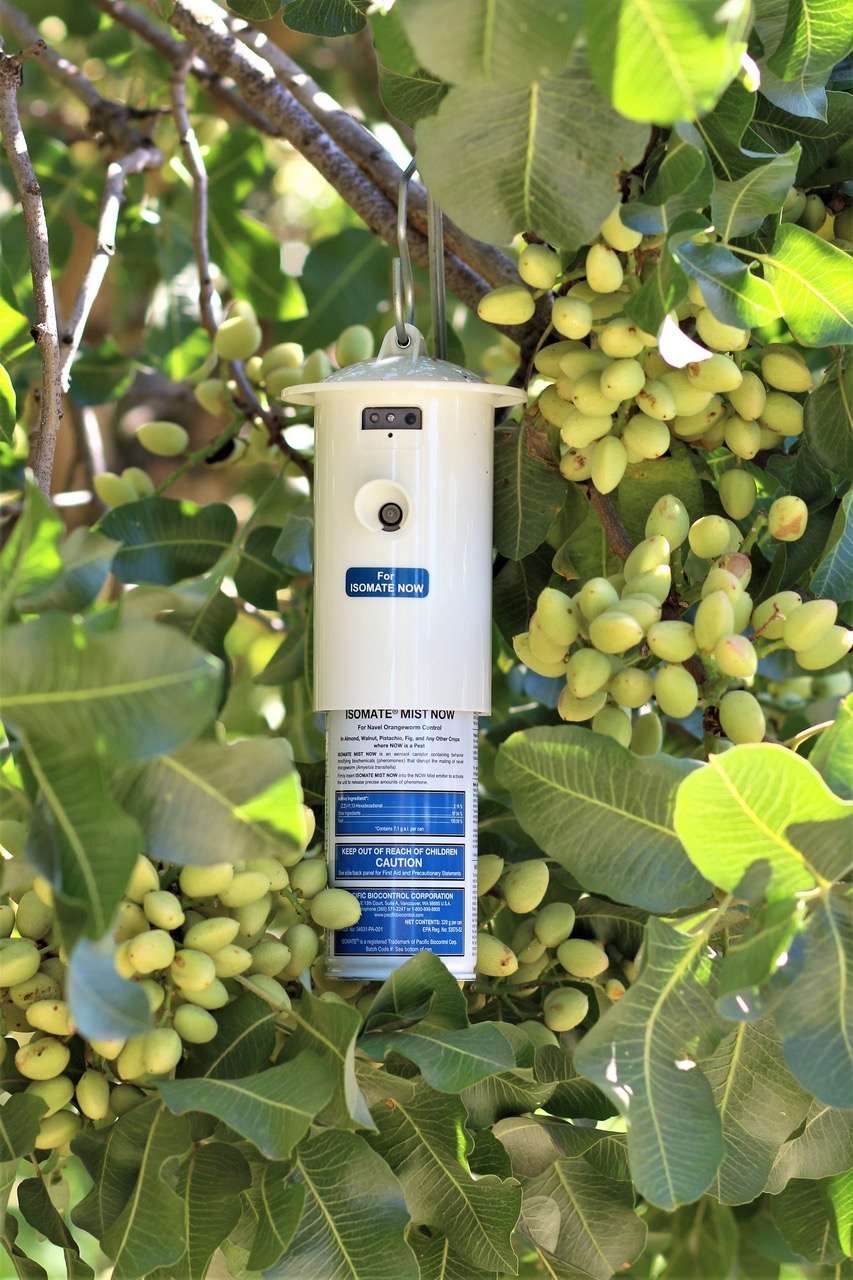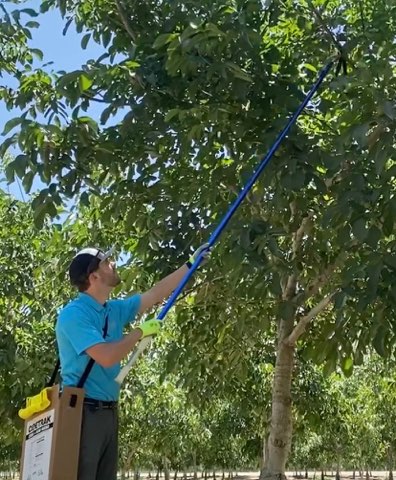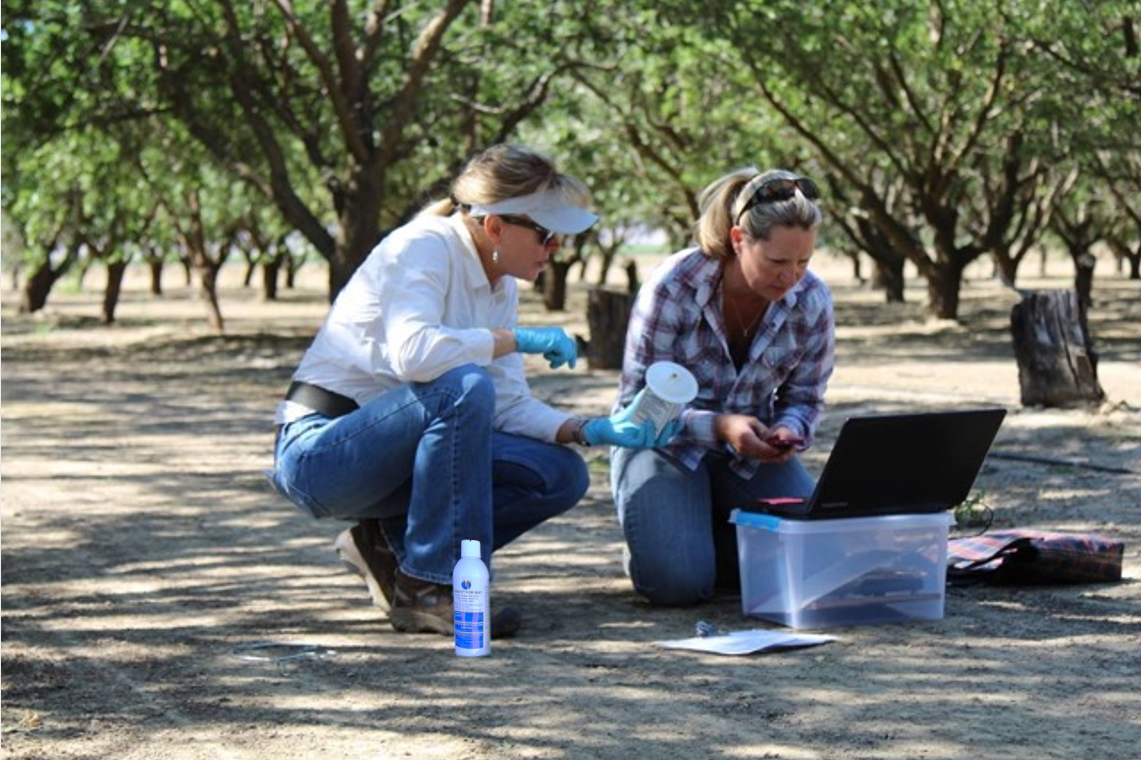
Almond, walnut and pistachio growers, depending on the growing region, list NOW (Amyelois transitella) as one of the most destructive insect pests in their orchards. Navel orangeworm feeding on developing nuts not only damages the kernels and lowers their value, it also can allow development of aflatoxin, a mold byproduct that contaminates the nuts and limits export opportunities.
Given the high value of tree nut crops in the West, it is not surprising that crop protection technology for insect pests continues to evolve. As navel orangeworm became a major pest, first in almonds and later in pistachio and walnut orchards, crop protection companies understood that pesticide applications alone were not a long-term solution to controlling this pest. Insecticide resistance issues with some chemistries and restrictions on pesticide use have posed control challenges. Development of integrated pest management programs by University of California farm advisors and researchers as well as new products that take different routes to NOW control are helping to reduce reliance on insecticides.
University of California research has proven that sanitation, removal of mummy nuts from the orchard after harvest, is the cornerstone of any NOW control program in tree nuts. Newer technologies are augmenting sanitation, such as mating disruption products and pheromone monitoring systems including lures and traps, all tools developed by crop protection services companies to reduce NOW populations and limit crop damage.
Mating disruption as a pest management practice is now done on more than 400,000 acres of almonds in the San Joaquin Valley, according to Almond Board of California. Pheromone products, tools that disperse pheromones, systems that relay trap counts and environmental conditions leading to hull split, and even trap designs are being developed to expand options on the market. Here is a look at a few of the products currently available and under development.

Pheromone Monitoring and Disruption
In addition to its Puffer NOW aerosol platform, which has been available for nut crop growers in California for two decades, Suterra in 2019 introduced a sprayable NOW mating disruption option to the market. This rounds out a comprehensive line of lures and multiple trap designs for NOW surveillance. The CIDETRAK line of control technology features a solid dispenser pheromone release platform, with constant release 24/7 through the entire season and beyond.
Pacific Biocontrol’s Isomate dispensers release over several months a synthetic pheromone that suppresses NOW mating. The pheromone “cloud” saturates the air, making it difficult for male NOW to find a mate.
In 2019, Suterra introduced a sprayable NOW mating disruption option to the market. Flowable pheromone (CheckMate® NOW-F) is applied using traditional pesticide sprayers via ground or aerial applications. It can be tank-mixed with a wide variety of agrochemicals or applied alone. When applied alone, lower volumes and higher sprayer speeds relative to conventional insecticides are possible, allowing for more rapid field applications. Flowable pheromone provides flexibility for growers to incorporate mating disruption into their existing IPM program, with the added benefit of a familiar application method and minimizing labor costs. Use patterns (number, timing, location of applications) can be customized to specific orchards and blocks based on pest pressure and population dynamics. The flowable microencapsulated formulation is effective for up to 30 days and may be ideal for orchards not suitable for aerosol mating disruptants, such as younger orchards where branches are less able to support the weight of dispensers, or those with irregularly shaped borders.
Semios has a mating disruption system that combines a pheromone dispenser with a monitoring system that records environmental conditions in orchards and sends data that can be accessed via smartphone or computer.
Peterson’s NOW traps use “kairomone lures” that emit odors that are attractive to mated female NOW. They contain a mix of ground almond/pistachios wrapped in a mesh bag that is suspended inside a trap. Baited traps are another tool that allows growers to see NOW pressure levels in orchards.

Tips for Smaller Growers
Brad Higbee, field research and development manager for Trécé, said there are opportunities for smaller growers to adopt NOW monitoring and mating disruption programs, but there can be challenges when neighboring orchards are not managed similarly. Advanced monitoring systems can detect NOW movement into an orchard and targeted sprays can be done. Research has shown that female NOW coming into an orchard are likely already mated. Higbee said they know from past work that immigrating female NOW lay their eggs in trees from four to 600 feet of the orchard border. Monitoring and comparing trap counts on orchard borders with traps at the orchard center can show potential border immigration situations.
Area-wide control programs for NOW are always more effective, Higbee said. Spray timing, mating disruption and sanitation are all more effective NOW controls if done in all neighboring orchards.
Christeen Abbott-Hearn with Pacific Biocontrol said Isomate Mist NOW is a good option for area-wide use and smaller orchards. Isomate Mist NOW is an aerosol emitter that dispenses pheromone when NOW are active and lasts season-long. The cloud of pheromone moves throughout the orchard with air currents.
“The bigger the continuous cloud of pheromone, the better,” she said.
Customized placement of the mister units creates optimal pheromone dispersion. Orchards as small as 40 to 60 acres can be successfully disrupted as long as growers take into account the potential for NOW from neighboring nut crops to fly into the orchard. Even then, there are management solutions, Abbott-Hearn said.
“We always want what is best for the grower and encourage working with each grower to determine the best fit for their particular circumstances. Sometimes, we recommend not using mating disruption but to increase sanitation or to not use mating disruption due to problem neighbors.”
Peterson Traps’ kairomone-baited NOW traps are used to catch gravid (mated) female NOW. Justin Nay of Integral Ag said this trap uses a kairomone lure of almond and pistachio mummies to draw in the mated female. Inside the trap, they become stuck to the glue and die with their fertilized egg load. Nay said the lure has a small active space in it is also measuring population density of the orchard, but not the neighboring orchard as the lures only call moths in from one or two rows.
Nay said he has found that matching the number of traps per acre to the expected number of female moths present at first flight results in capturing as much as 75 percent of the first flight. If there is a mismatch, and traps are overfilled, a good assessment of expected harvest damage can be made. With that information, an insecticide spray can be done at the right time. Nay said he uses the cumulative number of moths per trap from April 1 to June 15 to determine the threat level.
A grower or PCA still needs to check the hull split timing and flight timing to determine the right time to treat, he said.
Emily Symmes, entomologist and technical field manager with Suterra, said that, although a new option for NOW, Suterra’s flowable pheromone technology has been around since the 1990s. It is a proven mating disruption approach that has been effectively used to reduce damage caused by a number of other pest species in various cropping systems. Like any other pest management tactic, whether mating disruption or insecticides or cultural controls, efficacy and economic returns are maximized when implemented as part of an overall IPM program, Symmes said.
Mating disruption does work in smaller orchard blocks, Symmes said, but it becomes more effective in suppressing NOW reproduction and damage when neighbors agree to sanitation protocols and also employ MD in a strategic program. The return on investment also improves with MD coordination over larger areas, and with multi-year use
Abby Cox, Semios’ in-house pest control advisor and entomologist, said the company has introduced NOW Eco—the first organic pheromone-based aerosol for MD approved for use in California.

Variable Rate Technology
Centerpiece of Semios’ Integrated Pest Management system is its variable rate mating disruption solution. This approach is designed to target pheromone release during peak NOW activity. The system includes a wireless network of in-canopy sensors for tracking pest development and reporting environmental conditions. The sensors are linked with networked camera traps that enable daily pest counts to be delivered to the grower or farm manager with Semios web and mobile applications.
The Semios IPM system is built on a proprietary variable rate mating disruption platform designed to automatically target pheromone release during peak pest activity for maximum efficacy while sustaining prolonged coverage for late-season generations of NOW.
Semios’ wireless network of in-canopy sensors provides growers and PCAs real-time tracking of pest development in the orchard by reporting their in-canopy climatic conditions every 10 minutes.
The system is adaptable to any size orchard or block, Cox said, and the platform system saves time by performing the monitoring and data collection tasks.
As tree nut acreage continues to grow in California, ensuring crop quality has become a major focus for growers and PCAs. Newer NOW technologies are helping growers deal with NOW challenges by providing additional customized tools for incorporation into NOW IPM programs.










